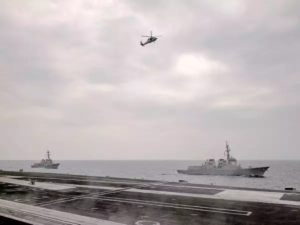U.S. strategy to counter china’s Naval power with anti-ship weapons

To challenge China’s expanding naval might in the Indo-Pacific area, the United States has implemented a plan of deploying vast quantities of mobile, inexpensive, and lethal anti-ship weaponry. This approach focuses on “affordable mass,” a term created in response to both Russia’s invasion of Ukraine and China’s growing naval capabilities. The idea is to dissuade China by overwhelming its defenses with a large supply of relatively affordable weapons.
Weapons such as the QUICKSINK bomb, which can be manufactured and delivered at a low cost, are critical components of this approach. QUICKSINK uses GPS guidance and a seeker to target moving ships and is part of the United States’ efforts to improve its anti-ship capabilities. The approach also includes the deployment of Long Range Anti-Ship Missiles (LRASM) and SM-6 missiles, which are designed to strike Chinese warships and destroy their defenses before hitting them with lower-cost weapons such as QUICKSINK.
The United States has also sent mobile missile systems, such as the Typhon system, which can launch both SM-6 and Tomahawk missiles, to important sites such as the Philippines. These systems offer flexibility and range, allowing the United States to challenge China’s sovereignty over strategic areas such as the South China Sea. Overall, the strategy seeks to counter China’s numerical superiority by emphasizing mobility, cost, and the capacity to deploy weapons fast in the event of confrontation.
In addition to air-launched missiles, the United States is deploying mobile missile systems that can be strategically located around the region. The Typhon missile system, which can launch Tomahawk and SM-6 missiles from land-based platforms, provides flexibility in responding to Chinese naval actions (The Defense Post). The deployment of these systems to sites such as the Philippines puts US forces within striking distance of China’s installations in the South China Sea, a major source of conflict.